
p12
Prioritize Your Time as a Leader
Implementing project management systems to manage time more effectively as a leader.
p14


p12
Prioritize Your Time as a Leader
Implementing project management systems to manage time more effectively as a leader.
p14
Why Dr. Marc Adelberg believes an innovative production model can help DSO leaders transform team meetings while drastically improving project management.




MANAGING EDITOR
Graham Garrison ggarrison@sharemovingmedia.com
ASSOCIATE EDITOR
Pete Mercer pmercer@sharemovingmedia.com
CONTENT WRITER
Jenna Hughes jhughes@sharemovingmedia.com
CIRCULATION
Laura Gantert lgantert@sharemovingmedia.com
ART DIRECTOR
Brent Cashman bcashman@sharemovingmedia.com
EDITORIAL BOARD
Rachel Shipley, DEO
Hilda Gonzalez, DEO
PREMIER PARTNER EDITORIAL BOARD*
JW Oliver, Managing Partner, SupportDDS
Brannon Moncrief, Principal & CEO, McLerran & Associates

PUBLISHER
Jake Puhl jacobpuhl@deodentalgroup.com
If you are interested in advertising, email media@deodentalgroup.com
DEO Magazine is published six times a year by DEO Dental Media LLC, 111 Congress Ave., Suite 500, Austin, TX 78701. Copyright 2024 by DEO Dental Media LLC All rights reserved.
POSTMASTER: Send address changes to media@deodentalgroup.com.
If you would like to subscribe or notify us of address changes, please contact us at the above numbers or address.
The opinions expressed in this publication are those of the authors. They do not purport to reflect the opinions or views of the Dentist Entrepreneur Organization, LLC, DEO Dental Media, LLC, or DEO Magazine. Also, the information in this publication is meant to give readers general information that they may find of interest. It is not intended to substitute for compliance, audit, advisory, tax, legal, or other professional advice. Readers should consult with appropriate professionals before making a decision to use any of the material presented in this publication.
Please note: The acceptance of advertising or products mentioned by contributing authors does not constitute endorsement by the publishers. Publishers cannot accept responsibility for the correctness of an opinion expressed by contributing authors.
*Diamond Premier Partners, through their combined annual investment across the various platforms and channels within the DEO, serve as honorary editorial board members for the duration of our annual Media Program.

BY JAKE PUHL
What does it take to thrive as a leader? We went straight to the source in this issue of DEO Magazine.
This edition is packed with inspiring stories of leadership, growth, and transformation shared by some of our most esteemed DEO Members. Each article dives into unique strategies and experiences that highlight the power of effective leadership in building successful dental organizations.
Dental entrepreneurs we talk to often say they face the challenge of balancing clinical responsibilities with the demands of leading and growing their practices. The pressure to maintain high standards of patient care while steering the business towards growth can be overwhelming. This issue is dedicated to helping you navigate these complexities and turn potential chaos into momentum for success.

Our cover story features Dr. Marc Adelberg, who introduces us to the “6 Types of Working Geniuses.” Marc explains how to use the framework to identify and leverage the unique strengths of each team member, driving productivity across the board. Understanding these working geniuses can help you manage your team more effectively, reducing friction and enhancing collaboration.
Here are some of the other highlights from this issue:
> Dr. Chris Martin explores “Getting Out of the Chair,” sharing critical steps to transition from hands-on practitioner to visionary leader, helping you free up time to drive your practice forward.
> Dr. Tony Molina shares his candid story of “Failing Up,” demonstrating how resilience and turning challenges into opportunities can set you up for greater success.
> Tiffany Fleisch delves into “Transforming Leaders into Multipliers,” emphasizing the importance of empowering your team to excel and share the leadership load.
> Dr. Dave Janash provides practical advice on “Coaching Your Team,” ensuring alignment with your practice’s vision and fostering a motivated workplace environment.
> Dr. Josh Renken highlights the significance of “Creating Systems to Grow and Scale,” providing stability and clarity during rapid growth phases.
These stories, while diverse in their approaches, share a common theme: leadership growth and development. In the ever-evolving world of dentistry, the ability to lead with vision, resilience, and empathy is what sets thriving practices apart. It’s about creating a self-sustaining organization where leaders inspire their teams, implement effective systems, and continuously innovate.
At DEO, we are committed to empowering dental entrepreneurs to become exceptional leaders. By sharing these stories and insights, we hope to provide you with the tools and inspiration needed to alleviate the anxieties of leadership and transform them into momentum for growth and success.
Cheers!
Jake Puhl
Unlock the secrets to building a thriving dental organization with DEO’s Growth Secrets Podcast.

Emmet Scott, DEO Partner and host, interviews a diverse line-up of dental industry leaders, revealing the secrets behind their success and extracting the tactics and tools they used along the way that can be incorporated by all listeners. In each episode, guests share their wisdom and insights in never-before-told stories that dig deeper into the challenges, failures, and triumphs that leaders face as they strive to build thriving organizations.


In this episode, Emmet hosts Jessie Stamp, Marketing Consultant, and Judy Webster, VP Sales & Service, both of PatientNEWS. They take a deep dive into modern dental marketing, both traditional methods like direct mail and digital strategies, covering how strategically planning your marketing efforts can help mitigate the impact of rising inflation and increase revenue. Listen in as you’ll gain actionable insights to amplify brand presence and navigate the evolving marketing landscape. (Sponsored by PatientNEWS)
EP
In this episode, Emmet hosts Max Baybak, Co-Founder and Chief Growth Officer, Influx Marketing, to discuss valuable insights on maximizing digital marketing strategies
for dental practices. They delve into the nuances of crafting a strong web presence, the power of consistent content creation, and why every dental entrepreneur needs to think of themselves as specialists. Max also shares expert tips on follow-up processes to bring in high-value patients and the advantages of niching down without limiting your services. (Sponsored by Influx Marketing)

Emmet hosts Kevin Tallman, CEO of Mango Voice, to discuss innovative dental communication systems. They delve into how cutting-edge technology can streamline practice communication, enhance patient experience, and improve operational efficiency. They also share practical tips for seamlessly integrating new communication systems, real-life success stories from dental entrepreneurs who have benefited from these advancements, and the critical role of effective communication in scaling a dental business. (Sponsored by Mango Voice)
Jake Puhl, CEO of The DEO, hosts Dr. Scott Sayre, Founder & Instructor at the Vesper Institute, and Dr. Chris Martin, Co-Founder & CEO of Village Dental, as they dive into the world of sedation dentistry. Learn how Dr. Sayre’s Cincinnati-based practices excel using advanced IV sedation techniques, and how Dr. Martin scaled similar models to achieve impressive revenue across multiple locations. (Sponsored by Vesper Institute)



By investing in his clinicians and staff, Dr. Dave Janash found he was also investing in the future growth and success of his company.
BY PETE MERCER
Teamwork is a critical ingredient to the success of any organization, which is why it is so important to get it right. To do that, you must establish a culture that helps to cultivate and prioritize team building early on.
Building a strong team is no easy task – it takes a lot of blood, sweat, and tears to get your team into a place where they can grow effectively. No good thing comes easy, but it’s worth the time and effort you put into it.
For the Thriving Leaders Series, DEO Magazine spoke to Dr. Dave Janash, founder and CEO of Underbite Dental Management, about the importance of building strong teams to grow your business. Underbite is
a New York City-based dental management group that works to provide practices with centralized tools and resources to help them grow.
One of the most basic ingredients for building a healthy team culture within your practice is listening to your team. This includes listening to learn about the opportunities your

employees desire for advancement and promotions, but also listening for opportunities to grow your business from those who work within it. What do they need? What do they see? How can their perspective optimize your organization?
When you are intentional about listening to what’s going on in your organization, you can make better, more informed decisions on some of the bigger strategic moves. Dr. Janash said, “It is all about listening to what people are looking for, listening to what opportunities the business needs. You need to be a good listener to understand how to help your team to be connected, present, and committed all in the same way at the same time.”
Every member of your team should have access to the tools and resources they need to successfully do their job, whether it’s training elements for continuing education or even the physical tools required to practice good dentistry. Dr. Janash hit a turning point while building Underbite where he found himself at management courses and conventions on practice management and revenue cycle and realized that he didn’t want to attend events like that without his team.
As they started to carve out their own reputations for themselves, team members created new opportunities for their own growth and development. For example, his human resources director decided to pursue a master’s degree, which aligned with the need to scale the department to meet the business’ needs. “As the company grew, so did Esida’s team. She used to be a one-person show
running all of HR; now she has a number of people on her team that handle recruiting, payroll, and compliance. It’s been a major joy of mine to watch people develop, personally and professionally.”
Part of a healthy team culture comes from the time that you spend investing in your team members. This is the kind of thing that is supposed to trickle down from the top. Healthy leadership leads with integrity, allows for feedback, and doesn’t expect the team members to do anything they would not do.
Creating spaces where your employees feel empowered and encouraged to be brave could have radical, positive effects on your business. By leaving the fear of failure at the door, you can push your team to take on bigger risks than ever before. That level of investment shows your faith in the capabilities of your employees and the strength of your organization.
The act of passing down the work is an undervalued component of building a strong team. The reality (and hope) is that your employees
The act of passing down the work is an undervalued component of building a strong team. The reality (and hope) is that your employees will not hold the same positions as the years go by.
Your team members are a critical piece of the puzzle, which requires motivation, incentivization, and encouragement at every step. Leadership that emphasizes these things will get better results from employees and more efficiency for the organization.
Dr. Janash said, “In addition to investing in the people, it’s important to create a brave space, rather than a safe space in the workplace. It’s not OK to be just safe, because safety doesn’t get you anywhere. Be brave. Create an environment where people can talk to you candidly about their goals, their concerns, and their weaknesses.”
will not hold the same positions as the years go by. They should be taking on new responsibilities that continue to challenge and push them forward.
Essentially, this means that you need to be training employees to hand down and take on work as responsibilities change. There shouldn’t be one person who knows how to do certain things – train the up-and-coming employees on the ins and outs of different tasks and processes around the practice to ensure that you have someone to fill those roles as they become available.
“I think it takes a real leader –not a manager, but a real leader – to

influence and develop people and essentially offload various tasks,” Dr. Janash said. This is especially true for any part-time employees that you may have – they need a light at the end of the tunnel, without the feeling of being strung along for busy work.
“There’s always going to be the need for a part-time person, and it can be stressful to be part-time. But if you continue to grow the DSO and continue to offer a personal and professional path for them, they will have a better idea of what the future will look like with your practice.”
You won’t get anywhere with building your team without focusing on team development, both personally and professionally. It’s the only way for them to improve, especially as your organization continues to evolve. But it’s not all up to leadership – your team must want to grow.
Dr. Janash said that it must be self-led, at least on some level. “They have to want
it on their own. I can’t force people to get on planes and go to conferences outside of dental to develop themselves. A lot of that must be self-led or at least promoted. Sometimes, you have to sort of push people in that direction.”
By providing opportunities for growth and coaching for your team, you can create an environment that is focused on the inherent value of development. Whether that’s through continued education opportunities, training opportunities, or even opportunities to take on new responsibilities, your employees should have options to chart the next steps in their career.
Even though the development of your team isn’t entirely up to the leadership, it also wouldn’t be possible without the influence of the leadership team. By investing in their future and offering development opportunities, you can leverage the success of your team members and your organization to drive growth and productivity to move forward.

in 2018 by David Janash, DMD, Underbite is a New York City-based, people-first dental support organization. Combining customized strategies with the same resources used by much larger DSOs, the group owns, operates, and provides practices of all sizes and styles with centralized tools and solutions to help them grow and thrive.
How Dr. Chris Martin took the next step in his leadership development without missing a step operationally.
BY PETE MERCER
Many dental leaders today are wondering whether it’s time to take a step back from operating in the chair. Indeed, there are many important components to running an efficient, successful dental group practice beyond just the clinical aspects. This isn’t an easy call for everyone, but it might be the best thing you can do for your organization, fellow doctors, and your team.
The hard part is the transition itself. Production is what many dentists do best, so you need to ensure that your business acumen is where it needs to be to run your organization and that you still have your company staffed at the appropriate level for the clinical workload. Finding the right path and timing can
be tricky, but it could prove to be an invaluable move for your professional development and the profitability of your organization.
DEO Magazine spoke to Dr. Chris Martin, founder and chairman of the board for Village Dental, about cutting down his time operating in the chair so he could focus on other
aspects of the business. Village Dental is a multi-site dental organization based in Raleigh, North Carolina, with a major focus on sedation dentistry via IV sedation.
Dr. Martin said he has effectively reduced his time in the chair to zero. By necessity, he has cut his chair time, but he truly enjoys the practice of dentistry and loves having the option to practice when the need or want arises. Instead, he pours his energy into other areas of Village Dental.
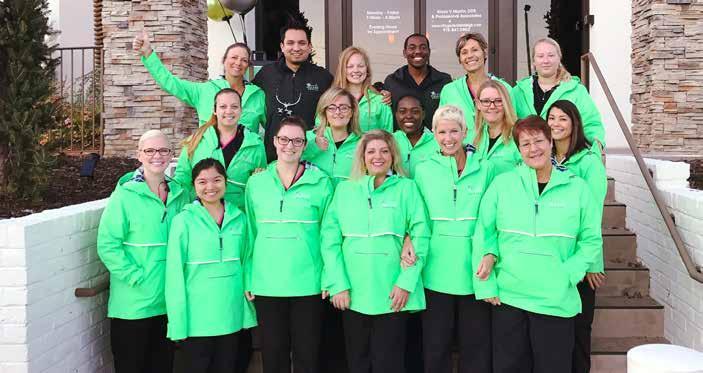
> You: Executive Mindset
It all started during the COVID pandemic when the team and organization needed him to step into a leadership role and out of 40 hours per week of chair time. Dr. Martin and the organization are big proponents of the DiSC behavioral profile for ‘best seat on the bus’ analysis. To better understand his perspective and interests regarding the workplace, Dr. Martin took a DiSC profile test, a personality assessment that focuses on four personality profiles: dominance, influence, steadiness, and conscientiousness:
> “D” personalities are more dominant, task-oriented and emphasize results.
> “I” personalities focus more on relationships and influencing others.
> “S” personalities are dependable and value cooperation and sincerity.
> “C” personalities place an emphasis on quality, accuracy, expertise, and competency.
It turns out Dr. Martin is high on the Influencer profile. Although he truly enjoys dentistry, his particular personality profile was well-suited to step up and lead during the difficult time the team was experiencing. “My profile is a high ‘I,’ so I’m like the Oprah Winfrey of our company,” Dr. Martin said. “Discovering that teaching dentistry could be a point of strength for me was enlightening and worked well during the difficult time we were experiencing during and postCOVID. I really enjoy being with people and interacting with teams. This works very well for me personally and helped fulfill my vision to build a dental business, not only a dental practice.”
Once he decided to take a step back from the chair, he needed to fill that role to ensure that there were no gaps in care. Village Dental has found that the DiSC tool is helpful in knowing which team members, including doctors, are best suited for

long-term associate/team member roles and which ones may want to step into leadership.
Village Dental is using the assessment company-wide to better identify strengths and roles. An assessment like this is a powerful way to identify potential leaders in your organization that you might not have seen before.
Based on the results, take the time to sit down with your team to discuss what this means and how they can chase their own purpose within your company. It’s important to understand that all personality profiles can lead, but there are different strengths they draw from and will thrive or fail depending on the ‘seat on the bus’

they are leading from. You might have someone in a position where they aren’t fulfilling their potential – encourage them to take the assessment and trust the process. These are the kinds of decisions that can change everything. As an Owner/Doctor it is very hard to see the team operating if you have your head down and involved with patient care full time.
Like most transitions, moving from the dental chair into a more executive role is going to be a multistep process that will take time to fully implement. There are so many doctors out there who have focused on production for their livelihood
because production is what brings money into the practice. ‘Leadership is not about Production, it’s about RE-production’. Building others up to think and perform as you do is the key. This is what makes getting the transition right so important.
For Dr. Martin, the most important component of this process was having great training systems to bring new personnel up to speed. He talked about the idea of a “treadmill operator,” which is often the first stage of business. Essentially, this means that you are stuck on this treadmill of production, doing all the surgeries and making all the money. It’s exhausting.
“You can’t take a vacation because that’s a week out,” he said.

“That is 25% of your revenue gone and there goes all of your overhead, so you made no money that month. When you come back to work, you have to go two more weeks to build your schedule back up. At that rate, you have had a two-month window where you did not make any money. That’s a miserable place to be as an entrepreneur.”
The best way to make this transition is to train the people who are going to take your place. Take the time to dial into the kinds of procedures and processes for your dental practice, ensuring that each of your team members understands in great detail what your top revenue generators are and how they should be performed at your organization. Iron out the methodology and create training materials that your doctors can reference for each step of the process.
Dr. Martin said, “You really have to spend that time on the front end to get those systems in place, so that you’re not just saying, ‘Hey, you’re a doctor! Come on in and do dentistry.’ I have never seen that work and I think it’s a recipe for disaster. I want to be able to go in and know that the quality of the dentistry, the staff experience, and the patient experience is the same in each of our pods in each of our offices. It’s also very important to keep in mind that you are going to feel that it’s ‘always broken’. That’s a blessing and a curse. Lean into it. That means you care, and learning how to let go of the things you cannot control and have the strength and discipline to prioritize and work the problems you can control, is the new paradigm you must accept. So do as Dave Ramsey says: ‘Take courage…and lead!’
The value of building strong partnerships.
BY PETE MERCER
The leader’s journey never ends. There are peaks and valleys at every stage, which brings varying levels of confidence and anxiety. There will be plenty of wins and losses as well. This is what it takes to walk down this road – today’s leaders are faced with more challenges and obstacles than ever before, while also having more opportunities for success and prosperity.
For the Thriving Leaders Series, DEO Magazine spoke to Dr. Tony Molina, the head of partner acquisition and development at Guardian Dentistry Partners, about building partnerships and learning hard lessons on the job. He has had experience with all the highs and the lows of owning and operating a
dental practice, using those experiences to build his career into what it is today.
Guardian Dentistry Partners is a rapidly expanding dental partnership network with partners in Alabama, Florida, Michigan, New Jersey, New York, North Carolina, Pennsylvania, South Carolina, Texas and
Virginia. Guardian works to improve the dental industry through partnerships that support their dentists and change the industry altogether.
value of building like-minded partnerships
Building partnerships is a foundational component of running a business. No matter what stage or season of life you are in, you will likely need to build a partnership to sustain your business practices. Ideally, this will be with someone you trust and share the same values, but it does not always work out that way.

Dr. Molina owned a private, feefor-service dental practice in Florida for over 20 years. After that ended in 2012, he was looking for opportunities that did not require him to be practicing as a dentist. In Dallas, he met a couple of periodontists and decided to form a hub and spoke partnership where one of the periodontists was in the main surgical center and Dr. Molina would run a series of offices that would funnel patients into the surgical center.
They bought an office together but quickly learned that they were not compatible. Dr. Molina said, “We did not have the same financial vision on how to manage the office, which was the first lesson learned. You can plan all you want and think you know how it is all going to work out, but until you get into it, you do not really know what people’s expectations are.”
Partnerships often work like marriages – you are committed to the business and to each other, even when things get hard. In sickness and in health. Marriage can be a beautiful thing, but it does not always work out. In fact, marriages and other long-term relationships often end over money.
The most misunderstood thing about partnerships is that you do not have to agree on everything. You probably will not agree on everything, but it’s all about how you compromise in the hard moments to ensure that the business works.
It can be hard to find a business partner. It requires a sense of trust and vulnerability with another person over a huge investment.
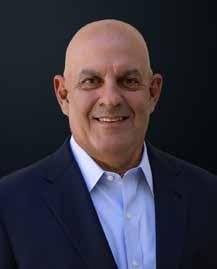
Finding a person or group of people that you can trust is the first step.
Eventually, Dr. Molina found the right partners to help him build a couple of dental practices in Dallas. The key to their success? Playing off each other’s strengths. Dr. Molina’s strength is in operations, while his business partner was better suited to the financial aspect of the practice.
“You have to be sure that you are aligned financially and philosophically,” Dr. Molina said. “For instance, my business partner could not go in and run a dental office, but that was the knowledge I brought. What he did was keep me very focused on the numbers. Which worked for us, because he was not there all the time. He was relying on me for the day-today operations, and that is what leads to the numbers.”
When you have built a partnership with another person or even multiple people, try to leverage each other’s strengths to build checks and balances that improve the processes within your organization. Complementary skills are key here, which
would allow you to tailor the organization to your strengths.
Dr. Molina came to Guardian Dental Partners in partnership development in the early years of the company, folding his existing practices into the larger group. In those days, Dr. Molina was still flying back to Dallas to run the group of offices that he started while actively looking for new partners for Guardian.
He said, “My whole idea was to tell people that we are not here to change how you practice. You are obviously running a very strong practice with great numbers, which is why we are interested in partnering with you. We partner with dentists to alleviate some of the stress of running a dental practice. That resonated with the right kind of people in the right way.”
Currently, Dr. Molina utilizes his knowledge of operations to efficiently provide support to the dental facilities partnered with Guardian. Through his role, he has built an infrastructure to budget for repairs and maintenance for all the facilities under his umbrella. This allows him and his team to forecast future budgets and allocate the appropriate funding for their various projects.
He said, “If our partners want a piece of equipment, they have to build a business case for it. We have our set forms where they requisition what they need and what they need it for. If they add a certain piece of equipment, what can they anticipate the doctor, or the hygienist, is going to be able to do with it?”
>
Systems to accomplish the goals set during a dental company’s annual planning meeting.
Winning the game before it starts means planning ahead and setting clear and achievable goals for the future.
Annual planning can help your organization do this and is a form of strategic goal setting that begins with company leaders and trickles down to specific project and task execution within dental teams.
Unfortunately for many companies, things discussed at annual planning meetings are like New Year’s Resolutions – goals that leaders get excited about but within a couple of weeks lose focus or momentum due to unclear objectives, staffing turnover, crisis management, or even lack of the systems necessary to implement the ideas.
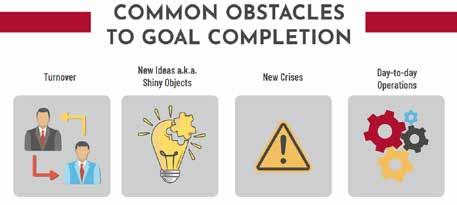
While there may be valid reasons for not following through with the goals and priorities created during an annual meeting, it sends the wrong message to team members that:
> Leadership doesn’t have the integrity to follow through on their goals and vision.
> Leadership is not competent at setting goals that matter and stand the test of time.
> Team members shouldn’t get too invested in any new goals/projects because leadership will probably change their minds soon anyway.
> The squeaky wheel gets priority.
Fortunately, there are systems and processes that can be enacted during a dental team’s annual planning meeting to successfully achieve company priorities. If teams are given easy-to-understand and attainable projects based on systems, they can have a clearer approach and be more likely to accomplish objectives.
Annual planning should consist of a one- to two-day meeting that includes each of the leaders and executives within a dental practice. But too often, the leadership team
comes into these meetings flatfooted because they didn’t do the necessary prep work.
Before the meeting, leaders should gather the needs of each practice, and team, far in advance, so that everyone arrives ready and prepared to discuss ideas. These internal team meetings are an opportunity to listen to everything that is needed within a company, considering everyone’s perspective – from the front desk to the doctors. This provides the leadership team with a more grounded look at what the organization needs.
Leaders should immediately put their team’s list of ideas into a document, using organizational tools such as Google Docs, Asana, or a spreadsheet (find a place that works best for the company). All ideas should be documented in one place (such as a specific planning meeting spreadsheet), including the name of the idea and what team/individual that the idea originated from. Once the individual team meetings and idea spreadsheet are complete, leaders will be prepared for the annual meeting.
Dental leaders can use a tried-andtrue project management system called IDOPE for the annual planning meeting. The first step, ideate, is covered with those internal team member meetings to generate ideas. From there:
> Document. If ideas aren’t written down, it’s harder to judge them, evaluate them, or determine their value. Don’t worry about determining all the details about an idea at this stage. The goal is just to capture the gist of the idea.
> Organize. Flesh out all ideas with a description of the scope of the idea/project, the ROI for the project, who the lead would be on completing the project, and who would be consulted on this project.
> Prioritize. Weigh the ideas against each other based on revenue vs. expense. Look at the project lead to see whether one team or individual is being overloaded. Look at the amount of effort and time it might take to accomplish this idea. Order your priorities accordingly, and confirm buy-in from all leaders on this prioritization.
But which ideas should be at the top of the list? The DEO has two helpful tools to help leaders in this area. The first is called the Customer Stack Tool. This tool asks the questions, “How would this idea impact [fill in the blank with your primary customer]?” Another useful tool is DEO’s Constraint Assessment List. This resource has a 15-point checklist including financials, collections rate, scheduling availability, facility capacity, staffing model management team, and more – which can help dental practices determine which goals to focus on as a company first.
Prioritize the projects that directly benefit the customer first, as they are the primary revenue source. Focus on goals that meet the needs of patients first, then clinicians, dental assistants, and treatment coordinators. If all those priorities are already met, then move to projects centered around scheduling, collections, marketing, and support services.
Remember when determining year-long priorities to consider the availability of a company’s resources and if there is time to explain and clarify systems around the project for each team. Ordering priorities correctly is essential to their completion.
The final step of the annual planning meeting is to create a process for executing ideas. Determine clear systems that ensure that the project will be completed at a high level by teams. Leaders can accomplish this by setting a deadline for completing the project, having a clear, updated status of the project in a shared document that is consistently monitored, and encouraging staff to update the project spreadsheet frequently with a percentage of project completeness.
Leaders should also outline the next actions for all projects in the document for staff’s continued progress, including notes and links to help dental teams complete the project successfully.
Building out systems takes a company’s annual planning meeting to the next level, growing the team’s integrity and success.
The more a system and process are fleshed out in the annual planning
meeting, the better teams can accomplish annual goals. If leaders plan and prioritize ideas that focus on patients and office staff while clearly defining the system and process for accomplishing each goal, annual planning meetings can run smoothly and set up teams for success in the upcoming year.
Elements of an annual planning meeting
> Do some legwork in advance
> Get away from your day-to-day environment
> Include team-building activities
> Review the past year –Look at what worked
> Review the past year –Look at what didn’t work
> Determine organizational needs
> Reverse engineer your goals
> Handoff to a project manager
The annual planning process requires:
I - Ideate: One individual to collect ideas
D - Document: A place to document ideas
O - Organize: A place to organize ideas
P - Prioritize: A method for prioritizing ideas
E - Execute: A process for executing on ideas
Implementing project management systems to manage time more effectively as a leader.
Growing your own skills as a dental leader helps to move teams, practices, and the company as a whole forward.
Dental company leaders must be clear, concise, and confident in order to grow their business, and “a strong leader embodies the proper skills to ensure that the company runs smoothly, overseeing that daily responsibilities and long-term projects are well managed,” said Amber Nish.
So, how exactly do leaders guide teams with clarity and grow confidence in their professional skills?
Amber Nish, a Marketing Coach at DEO, and Kyle Scott, a Project Manager for 70 plus doctors and offices within a DSO, shared their insights into how to prioritize your time as a team leader.
Developing leadership skills
As a leader, overseeing all the aspects of a dental business, including managing teams, day-to-day operations, and achieving company-wide goals can often be daunting. To address this and find clarity, implementing systems can help simplify the process of managing people and assist them in completing both daily responsibilities and ongoing projects.
Leaders can grow their confidence by implementing specific practices in the workplace such as aligning teams by setting clear priorities, holding staff accountable for completing what is most important now, not chasing distractions, and encouraging staff to achieve maximum performance in their responsibilities.

“Leaders should provide teams with clear priorities and systems to get tasks done. After delegating tasks and providing teams with the tools to accomplish them, trust that staff can handle them,” said Nish.
Providing teams with priorities and systems is known as project management. Project management is a critical skill to master in the workplace to best prioritize time as a leader. According to Nish, project management allows leaders to delegate tasks and successfully get ideas
across to teams. Leaders that are skilled in project management are better able to align teams around what’s important and give staff clear directions so they can achieve actual results.
Leaders rely on the systems associated with project management to plan, best allocate resources, and give teams the tools they need to succeed.
Nish, Scott, and the DEO team came up with an analogy to convey the importance of project management with the example of three employees facing the task of swimming across a lake to the other side successfully. In this scenario, each employee is standing at the edge of the lakeshore trying to decide how to get across the water, and each individual has a different approach.
Person One rushes into the water, jumps in, and immediately starts paddling across the lake. This person doesn’t have a plan initially and doesn’t know how they’re going to complete the goal, but they trust themselves to figure it out in the moment.
Person Two approaches the challenge by pausing to research which swimming stroke would be best to get across the lake, what dangers or challenges there might be, and if there are any currents present in the lake. At this point, Person One is making more headway, while Person Two is still in the research phase.
While all of this is happening, Person Three begins the process of building a boat. Indeed, the person that takes the time and effort to build the boat will ultimately be the individual that completes the task first. In this example, the person that built the boat would be the one in a dental organization that would first gather the teams, tools, resources, and support necessary to complete the task through prior planning and research.
The lake scenario exemplifies why project management is so valuable — it provides teams with the systems they need to complete company tasks and goals.
“Often where leaders fail in project management is by not conducting the proper research first,” said Scott.
Project management can take workplace chaos and simplify it into a process — through planning, organization, motivating teams, and controlling resources, goals can be completed within a defined timeframe.
Project management itself requires step-by-step processes that leaders
Leaders should prioritize projects based on the greatest return on investment (ROI) for the company, instead of basing decisions on emotion, excitement, and feelings.
should follow to best implement and communicate systems with their dental staff.
“To organize, budget, and plan for projects, leaders should follow the IDOPE acronym with the following steps: Ideate, Document, Organize, Prioritize and Execute, as a process for conducting all project management planning,” said Scott and Nish.
First, leadership should write down all the ideas or goals they want to accomplish, document them, determine specific timelines, organize each project based on priority, and then begin executing them. The IDOPE acronym serves to simplify project management, allowing leaders to begin project planning systems no matter where they are currently at as a company.
Leaders should prioritize projects based on the greatest return on

investment (ROI) for the company, instead of basing decisions on emotion, excitement, and feelings. Leadership teams should be able to say that each of the goals and priorities that are being worked toward have a measurable and significant impact on the company.
When determining project priority, leaders should make decisions that support doctors, clinical care staff, and clinical support staff first — as this will directly support a dental business’ primary customer, the patient. An example of a type of project could be identifying the need for a new associate (a company makes about 30-40% more revenue depending on if they hire a new associate). Another example is to invest in building career paths as a company to retain strong employees.
Once a company determines all the projects they want to accomplish and has gathered and discussed them as an executive team in a meeting, they can begin project management plans.
The next step of project management is to choose the appropriate systems to help teams complete priorities. According to Nish, “there are three different ways to tackle a priority within a dental business, including strategic initiatives, projects, and tasks.”
> You: Prioritization
The first type of a system is a strategic initiative. When determining a company’s strategic initiatives, leaders should first determine what challenges within the business needs to be solved, the definition of success, and the aspects of the problem that are not going to be solved with this specific system.
Strategic initiatives are composed of multiple projects. A strategic initiative is multi-department or company-wide, and complex. It takes more than an operational quarter to complete, and the “how” isn’t always clearly defined. Sometimes, it takes starting the project to realize that it is a strategic initiative and will require complexity and further projects. When approaching strategic initiatives, remember that leaders must break down all the ideas they have into systems that staff can follow and accomplish.
Next, a project is how teams execute a strategic initiative. Projects can also be thought of as the vehicle through which a strategic initiative is executed. The timeframe of completion for a project is between 30-90 days, with specified start and end dates. Projects also have a predetermined scope, budget, and timeframe, and are often comprised of multiple tasks.
Tasks are small, individual steps taken to accomplish a project. Tasks are transactional and tactical, can be done in two weeks or less, and can be assigned directly to an individual
> At the company wide level (ex: launching denovos) because it’s multi-department
> Takes more than a quarter to complete
> Requires scoping
> The “how” isn’t clearly defined
> Is complex
> Is comprised of multiple projects
on a team. It is very easy to define what a completed task looks like.
“Leaders should make sure teams understand the difference between a strategic initiative, a project, and a task. Before assigning staff these responsibilities, explain the differences between each system and ensure teams fully understand each aspect,” said Scott.
For example, centralizing company scheduling is a strategic initiative, as it is multi-departmental and complex. Standardizing scheduling and standard operating procedures for all 7 practices is a project because it has a predetermined scope, and finally, scheduling meetings with a software vendor is a task, because it can be accomplished quickly and there is a clear path to get there.
For each priority, leaders should create a spreadsheet with the name of the project, the names of each of the tasks to get there, who the task is assigned to, what the due date of the task is, and a section on the spreadsheet for details, notes, or comments that everyone can edit.
Breaking priorities down into strategic initiatives, projects, and tasks provides staff with clear systems and language to ensure everyone on a team is aligned and doesn’t feel overwhelmed by their auxiliary responsibilities. Step-by-step systems serve to help leaders prioritize and effectively lead their teams to success.
Projects are the vehicle through which a Strategic Initiative is executed.
> Timeframe is between 30-90 days
> Has specified start and end dates, and finite resources.
> Has a predetermined scope, budget, and timeframe.
> Is comprised of multiple tasks.
Individual step to accomplish a project
> Transactional & tactical
> Can be done in 2 weeks or less
> Can be assigned directly to an individual
> Easy to identify what “done” looks like

Nish is a Marketing Coach at DEO, and through her position, has gained extensive experience in dental industry marketing. Nish’s previous experience in the marketing field was during her time as the Chief Marketing Officer for a dental group that she grew from seven locations to 30. Nish is always excited to share what she’s learned over the years as a marketing leader in her career and at DEO.

Kyle Scott is a Project Manager for 70 plus doctors and offices within a DSO. He also works at DEO to organize and prioritize long-term projects. Scott has extensive professional experience in marketing, project management, and leadership development within the dental industry.
BY JACOB BOLTON, ASSOCIATE, HOLLAND & KNIGHT, & SAM JACOBS, ATTORNEY, HOLLAND & KNIGHT
In the world of dental practice management, effective leadership goes beyond clinical expertise and business acumen. Strong dentist leaders understand the crucial role that the regulatory landscape plays in the growth and sustainability of their practice. By paying close attention to regulations, especially those set forth by state dental boards, these practice leaders can ensure compliance, maintain high standards of care, and greatly increase their odds of successfully navigating the complexities of the dental industry.
The dental regulatory landscape is comprised of various rules and guidelines designed to protect patient safety, ensure quality care, and uphold the integrity of the profession. These regulations are enforced by various entities, with state dental boards playing a pivotal role. Each state dental board has the authority to license dentists, set standards for practice, and enforce disciplinary actions when necessary. They also have the power to block acquisitions or transactions that they feel inhibit the quality of patient care (including DSO transactions) and can require very detailed memorandums and disclosures of such transactions. Each state dental board is different, and it is important to know the rules by which your state dental board plays.
The best dentist CEOs recognize the importance of staying informed about these regulations. They understand that compliance is not just a legal obligation but a fundamental aspect of professional responsibility. By staying up to speed on changes in laws, guidelines, and best practices,
they can proactively address potential issues and avoid costly legal pitfalls.
One of the primary responsibilities of state dental boards is to license and regulate dental professionals. This includes setting requirements for continuing education, clinical practice standards, and ethical conduct. Good dentist leaders ensure that their practices meet all licensing requirements and that staff members are adequately trained and certified.
Compliance with state regulations also extends to the physical and operational aspects of the dental practice. This includes maintaining proper infection control protocols, ensuring the safety of dental equipment, and adhering to patient confidentiality laws such as the Health Insurance Portability and Accountability Act (HIPAA). By prioritizing compliance, dentists can provide a safe and trustworthy environment for their patients.
As dental practices grow, the
complexity of regulatory compliance increases. Expanding a practice often involves opening new locations, hiring additional staff, and offering new services – all of which are subject to regulatory scrutiny. Good dentist leaders plan for growth by integrating regulatory compliance into their business strategies. This includes conducting regular audits, seeking legal counsel when necessary, and fostering a culture of compliance within their practices.
Moreover, leaders who are attuned to the regulatory landscape can leverage this knowledge to gain a competitive edge. They can anticipate regulatory trends, adapt their practices accordingly, and position themselves as industry leaders committed to excellence and integrity.
The ability to navigate the dental regulatory landscape is a hallmark of great dentist leadership. By staying informed about state dental board regulations, ensuring compliance, and integrating regulatory considerations into their growth strategies, practice leaders can help safeguard the success of their practices and uphold the highest standards of patient care. In an industry where trust and quality are paramount, this attention to detail sets exceptional dental practices apart from the rest.
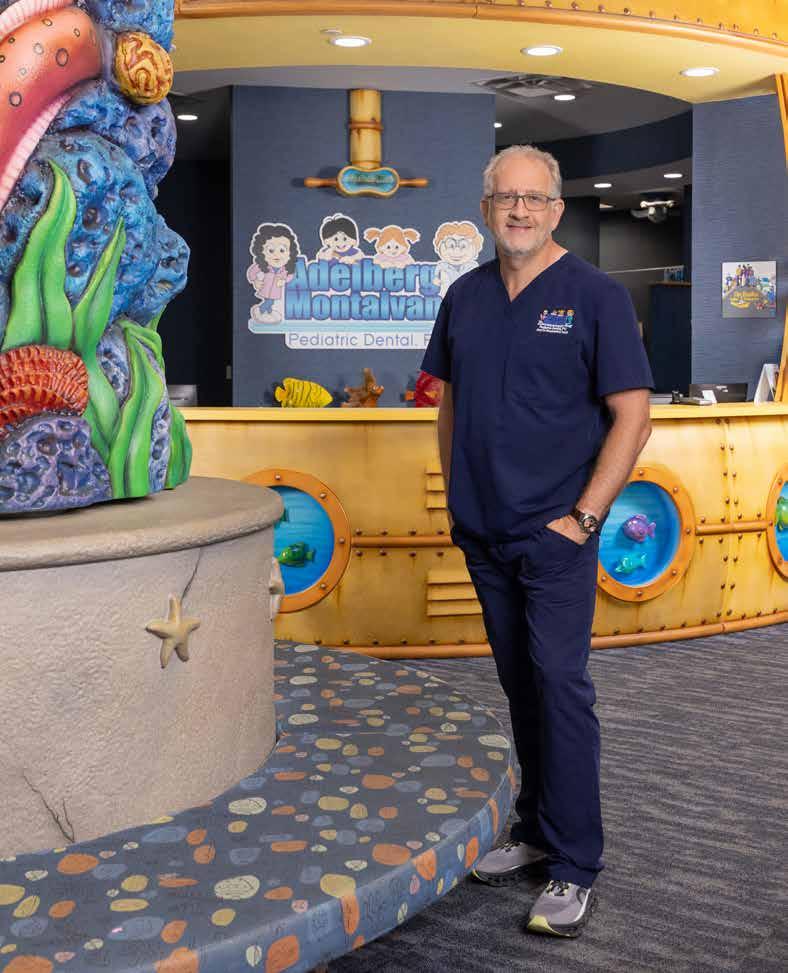
Why Dr. Marc Adelberg believes an innovative production model can help DSO leaders transform team meetings while drastically improving project management.
Picture yourself on an airplane flight. Over the speakers, you hear, “Greetings folks, this is your captain speaking. We are now cruising at 30,000 feet, and I’ve turned off the seat belt sign. You can walk around the cabin as you choose. Enjoy your flight!”
About two minutes later, the plane drops from 30,000 to 10,000 feet.
Sound scary? What if it gets worse? What if the plane climbs from 10,000 to 20,000 feet, only to plummet to 5,000 feet? It would be unsettling to say the least.
That’s called turbulence, and it happens in our work and home lives all the time, said Dr. Marc Adelberg, owner of New York-based Adelberg Montalvan Pediatric Dental and Orthodontics.
“Turbulence is a sign that you are not following a flow,” said Dr. Adelberg. “You should be able to figure out the problem, come up with ideas to fix the problem, fine tune those ideas, rally your team around the ideas, decide on the people who will make it happen, and decide which people will close it for you.”
But what if that’s not what is happening? A couple of years ago, Dr. Adelberg experienced this firsthand. It seemed like projects were always getting caught in a cycle of start, stop, start, stop. “Projects weren’t being followed through to the point of where I thought they should be.”
He was frustrated and determined to get to the root cause. While attending a leadership event in another state, he bought a copy of “The 6 Types of Working Genius: A Better Way to Understand Your Gifts, Your Frustrations, and Your Team” by Patrick M. Lencioni. By the time he finished reading the book, he knew he had found the missing piece to better project management. In fact, he not only wanted to introduce it to his team, but also to become a certified Working Genius Coach for the

program so he could pass on his knowledge to other dental leaders and organizations.
The Working Genius model focuses less on personality and more on what Dr. Adelberg calls “productionality” – 80% production, 20% personality. By understanding what somebody’s Working Geniuses and Working Frustrations are, you can break your projects out of turbulence while eliminating judgment and guilt as a leader, he said.
In his book, Lencioni identifies six Working Geniuses:
1. Wonder. These are people who ask lots of questions. They’re always looking for a better way to do something.
2. Invention. These people love generating new ideas.
3. Discernment. People with discernment are determined to make something better and give a lot of feedback.
4. Galvanizers. Galvanizers are your cheerleaders. They rally the troops and want to make the idea happen.
5. Enablement. Enablement people don’t care as much about the idea. They want you to know they are there for you and want to be part of the solution.
6. Tenacity. People with tenacity love checklists. They are your closers.
According to Lencioni, we all have two Working Geniuses, two Working Competencies, and two Working Frustrations.
Dr. Adelberg discovered his Working Genius was IG, or “The Evangelizing Innovator.” People with this pairing derive real joy and energy from generating ideas and convincing others of an idea’s merit. He also discovered his Working Frustration was TE, or “The Loyal Finisher.” People with this pairing derive joy and energy from completing tasks and responding to the needs of others in the pursuit of getting things done.
“My team will tell you that I’m really good at generating ideas. Follow through? Not so much,” Dr. Adelberg said. “So, I need people
with tenacity on my team who will close the deal and complete the task.”
Dr. Adelberg admits prior to this exercise, he had some individuals on his team who would occasionally frustrate him during meetings because they weren’t exhibiting all of these traits. There were those with great ideas but bad follow through. Others could take a project and run with it, but didn’t have much to offer in the way of inspiration. But through this process, Dr. Adelberg could stop feeling guilty about this when he realized they simply had different Working Geniuses and were


offering a different perspective and foundational element to their discussions. He moved from judgment to understanding.
“Now I don’t always expect everyone to be involved in the idea side,” he said. It’s not that they don’t care. I just don’t judge them like that anymore. But I know I can ask some people for their opinion a little bit further down the road, and I have other people where I know they’re going to be the ones to close it for me.”
There are essentially three stages of a project: ideation, activation, and implementation. In the Working Genius framework, each of those stages comes with two pairings. For instance, Wonder and Invention go well in ideation, Discernment and Galvanizers in activation, and Enablement and Tenacity in the implementation stage.
What typically does not happen in dental practices is the middle
Patrick Lencioni and his team provide a helpful assessment for “Working Genius” at www.workinggenius.com
When you take the “Working Genius” assessment you must complete the portion about what brings you joy, fulfillment, and energy. It’s critical to the entire process. “If you fill out the assessment on what you think you’re really good at, or what you think your team would want it to say –but not what brings you joy, fulfillment and energy – it won’t work. You must be self-aware,” said Dr. Adelberg.
portion. “We come up with great ideas and then we expect everybody to close on them,” said Dr. Adelberg. “But nobody asks whether this a good idea (discernment), or can we get our team to rally around it (galvanize)?”
For example, Dr. Adelberg’s team recently had an operational problem at one of their facilities. During their leadership meeting, Dr. Adelberg suggested they just have the office manager take care of it. “Then, no joke, all three Discernment people on my team said, ‘That’s a terrible idea. She’s got enough on her plate.’” Rather than getting upset, Dr. Adelberg considered what they had said, and thanked them for their discernment. Together, they moved on to other ideas that could solve the issue.
In another instance, they had a partner doctor who was passionate about marketing, but his Working Genius was Discernment and Enablement. Dr. Adelberg sat down with the doctor and asked him what type of candidate he thought would best complement his strengths. “The doctor felt like he needed somebody who he could give direction to, and then let him or her run with it,” Dr. Adelberg said. “When we finally hired our person for marketing, I picked somebody who is an ET – A Loyal Finisher. Every week we’re putting out fresh content via Instagram reels and TikTok videos. She’s getting orders in for our upcoming street fairs. Whether it’s producing content or ordering water bottles or new T-shirts or scrubs, she’s on it.”
Not every attribute will be well represented on a leadership team. For example, Dr. Adelberg’s team
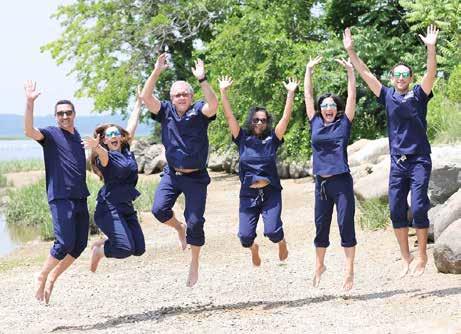

does not have anyone with a Working Genius of Wonder. So, in their meetings, they are intentional about coming up with the types of questions that a person with Wonder would ask.
> Speculate
> Question
> Ask Why?
> Better Way?
> New Ideas
> Love White Boards
> Love Wonder’s Questions
> Take Ideas and Evaluate
> Great Instincts
> Give Feedback to Ideas
Galvanizing
> Enthusiastic About Ideas
> Get Things Moving
> Cheerleader
> Rally the Call of the Galvanizer
> Get People to Help
> People-Oriented
> Check Off Boxes
> Love “To-Do” Lists
> The Worker Bee
Ultimately, using this model has allowed Dr. Adelberg and his team to tap into one another’s talents and create a common language. It has changed how they staff projects and provided a framework for innovation and work. And, it has improved productivity and morale.
“If you buy into this model, it can reduce friction,” he said. “And guess what? In the process you’re going to eliminate turbulence in your office.”
Stop hunting Fee-For-Service cases, and create a consistent harvest of profitable treatment.
BY DENTAL MENU
Are you a hunter or a farmer? Hunters look for specific prey and use specialized techniques and tools to kill and eat. Success can translate to a large meal, but it’s less predictable and more sporadic versus farming. On the other hand, farmers plant seeds, cultivate fields, and raise animals within the confines of fences and pens. Their harvest is more planned and predictable.
What does this have to do with dentistry and membership plans?
In a practice you can use specialized marketing and techniques to hunt fee-for-service patients. These FFS cases are rewarding because the fees are higher, and you don’t have insurance dictating treatment and patient outcomes. However, it’s hard to build a practice around sporadic hunting because once the work is done, you must convince un-insured patients to return on a regular basis. You are constantly chasing and marketing (hunting) for these cases.

Insurance patients on the other hand follow a process that more resembles farming. They typically schedule 6-month recall visits

because these services are included at no charge with their insurance plan. Your hygiene department is your farm. Un-insured patients need to be coming through your hygiene department on a regular basis to ensure natural, predictable treatment. If most of the patients coming in regularly for hygiene are insurance patients, it will be difficult to grow and produce consistent FFS treatment. The purpose of a membership plan should be to attract and retain FFS patients by having them come in on a consistent basis for preventive services and helping them accept and afford treatment with included discounts. What is the difference between a discount plan and a continuity (membership) plan? Examples of discount programs are Groupon or the fundraising cards you buy that have all the discounts to various places. You purchase a specific Groupon deal
at a discount to get the best possible price. True membership plans resemble Netflix, Amazon Prime, or a Gym Membership. You pay each month to have access to certain benefits or content.
Many of the dental membership plans we see are more of a discount style plan. They help case acceptance and are effective hunting tools to close treatment, but they fail to retain patients. If patients buy a set of services for a year and don’t renew until they come back to the office, you have a discount plan. Discounts are an important part of a membership plan, but your plan should do more than offer a discount to help close treatment.
True membership (continuity) plans get un-insured patients into your hygiene farm on a consistent basis by offering access to preventive services at specified intervals. There isn’t a renewal period each year. Instead, the patient pays each month (or year) to have access to exams, cleanings, x-rays, and other services. They can access those services at the intervals specified as long as their membership is active. In this way you sign the patient up once and let the program roll.
For more information visit: www.dentalmenu.com/ discountvsmembership or scan the QR code.

Arvory Dental’s business model cultivates freedom while providing centralized services to its practitioners.
BY GRAHAM GARRISON

There had to be a better way. For Dr.’s Clark Brinton and Seth Huish, the frustrations with the first decade of their careers had risen to a boiling point.
The two friends attended school together at OHSU. After graduation, Dr. Brinton went into public health through the National Health Service Corps but found the inefficiencies hard to deal with. Dr. Huish, meanwhile, was frustrated working at a group practice whose leadership made promises to associates that weren’t delivered.
“What Seth dealt with was the classic thing you see with an associateship, where they promise you the world and then you get there and it’s not as advertised,” Dr. Brinton said. “Then when you’re supposed to buy in, you don’t actually get a true buy-in, things don’t happen on the schedule that was proposed and it ends up being a worse deal. We’ve seen a lot of friends go through that.”
The duo wanted to break free of the traditional mold in a model that could still compete against corporate entities. Established in 2017, Arvory Dental has positioned itself as a hybrid where doctors can have a private practice feel, but with robust support services in the background.
Today, Arvory consists of a Portland, Oregon-based central holding company (the DSO), and nine local practices that each act as individual entities.
Arvory’s model is that of a dentist-centric, patient-centric group, with the efficiencies of the DSO model, but instead of giving a partner dentist, “pseudo or phantom equity,” they receive a legitimate 50% equity in the practice along with all the tax advantages, Dr. Brinton said. “We have the practice pay the bank note off … We look at it as a long-term partnership with the dentist and try to make it a win-win.”
Arvory has a slim management team at the corporate level because they want the doctors to have the space to lead their teams in the office rather than directives coming from the top down. They believe doctors are the natural leaders of dental practices. Thus, when doctors are empowered, things run smoother. “We’ve found dentists are motivated to lead their
practices, and they also want to contribute to the organization.”
Arvory’s brain trust meetings and group chat texts among the doctors allow them the space to do that. The monthly meetings cover the business side of dentistry and provide a space for partner doctors to lead the discussion on different topics and contribute to special projects for the group. For example, one tech-savvy dentist is introducing 3D printing in his practice. “Once he gets it perfected, we’ll deploy it out to everybody else,” Dr. Brinton said.
Another doctor with extensive experience in endo led the group through training on it. The brain trust meetings promote a spirit of collaboration. “We let them focus on where their passion is and their expertise,” said Dr. Huish.
A question Arvory often gets is, ‘Why would I give away 50%? Why don’t I just go do this on my own?’ That’s a great question, said Dr. Brinton. “For some personalities, you’re better to go do that, so let’s figure that out before we’re married to each other. If this isn’t the right fit, that’s fine. There are some docs that are alphas and lone wolves, and they need to own it and run it all, and that’s fine.”
What Arvory offers is a place for new doctors to shorten the learning curve. Instead of it taking them 10 years to get to a desired point, Arvory can help them do it in half or a third of the time, “because we’ve already figured out the admin side of it,” Dr. Brinton said. “We know how to run an office. We have built-in continuing education. We can teach you how to get efficient at the bread and butter quicker. We can teach you how


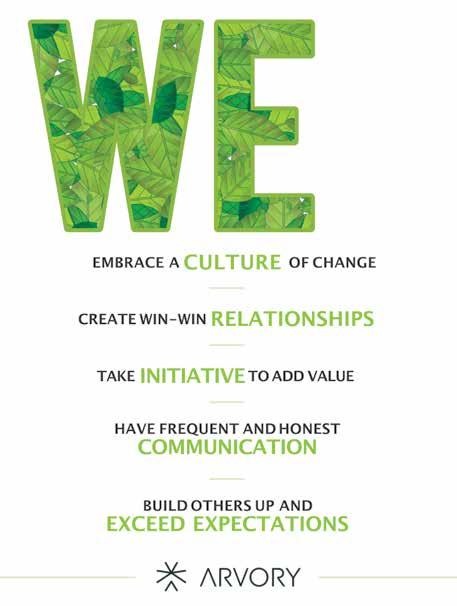
to do a treatment plan, how to present treatment to patients, and how to train your team. The value-add is getting you there quicker. Yes, any smart person could get there on their own eventually, but how much is your time worth? We want to accelerate your career through collaboration.”
Arvory encourages doctors to develop professionally by providing comprehensive resources in three key areas: clinical support, business support and professional development. Through tailored plans, Arvory helps doctors identify their specific needs and goals, and then offers ongoing check-ins and assistance to ensure their growth and success.
Indeed, Arvory is deeply committed to education and personal development. “We really encourage our doctors to get fellowships, travel around, and learn new skills,” said Dr. Huish. “It’s kind of like building a super GP where they’re placing implants, doing ortho, wisdom teeth – they’re doing all these enhanced things that they’re comfortable with. We encourage them to thrive. Patients don’t necessarily like being referred all around, so this enables them to do more within their own office and grow professionally to the top level.”
Arvory has a minimum CE budget of $5,000 per provider per year. “We want them to go spend money on CE,” Dr. Brinton said. “If they make a good case for spending $15,000 to $20,000 on CE in a year, we’ll approve it because it’s an investment. We know we’re going to get the ROI. We’ll see it come
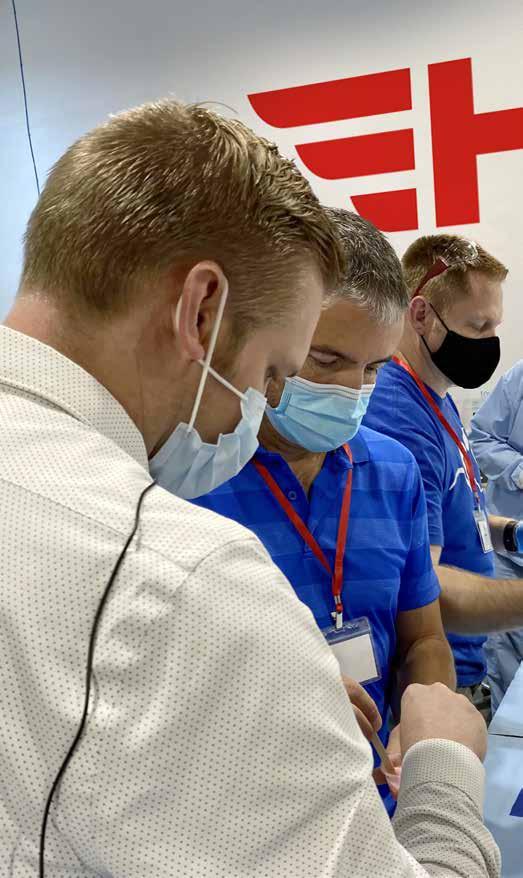

back into the practice through the additional procedures that they’re doing.”
The professional investment in Arvory’s doctors has shown clinical benefits, as well as a boost to the culture of the organization. “Staff have a better image of the central company because they see it as one that works through their dentists instead of around their dentists,” Dr. Brinton said. The doctors are more involved in the company-wide initiatives and training programs as a result. “For example, if we decide we’re going to do a laser training for the hygienists, we bring in the dentists first, explain it to them, they go back, they talk to the hygienist, they’re aware of the program, which also brings a better ROI for it because they’re on board,” he said.
Arvory also actively facilitates opportunities for doctors to engage in humanitarian trips, fostering connections with organizations in Hawaii, Mexico, Nepal, and continuously expanding networks, the company says on its website.
The efforts in Nepal have been particularly rewarding. Dr. Brinton said they were recently able to deliver 3D printers, an intraoral scanner and design software to dentists in Nepal. They helped train the dentists and
> Embrace a culture of change
> Create win-win relationships
> Take initiative to add value
worked with the dental school to develop a new program for students. What started as a humanitarian trip has blossomed into a business partnership. Arvory has hired a couple of the dentists that graduated from the Nepali Dental School as remote designers. Arvory is also working with the Nepali Dental School on a fluoridated toothpaste campaign that both parties are eager to implement.
Despite the freedom and autonomy that Arvory provides its doctors, to compete with large groups in today’s marketplace, economy of scale matters. For instance, Arvory is running an ad campaign in the Portland area at a size and budget that wouldn’t make sense for a standalone office. They can do that corporately for the individual locations while still allowing the doctors to run their practices.
Ultimately, Arvory’s vision has created an “easier lift” for independent doctors still looking to expand their skillset, leadership development, and humanitarian work among like-minded leaders. “We all work in collaboration together to make it happen,” said Dr. Huish. “We’ve all learned. And we put all our collective experiences together to succeed.”
> Have frequent and honest communication
> Build others up to exceed expectations
BY KATE REINERT, LDA, EFFICIENCY CONSULTANT, ZIRC DENTAL PRODUCTS
In business, a simple cost-benefit analysis is often the law of the land. But how good are we at accurately assessing costs that aren’t directly associated with a purchase or price tag? When it comes to our own dental practices, how skilled are we at recognizing costs brought on by clinical inefficiencies like disorganization?
The truth is, without a system that directly measures these costs, dental practices have no good information on the costs incurred by inefficiencies resulting from disorganized systems. Without being able to see the actual dollar amount, dental teams instead “feel” the costs of disorganized systems in various manifestations including stress, loss of valuable time, confusion, hindered team communication, difficulties in training, and subpar patient experiences, to name a few. And when navigating staffing challenges, this is simply not acceptable.
The fact is, there is simply no place for confusion or error in the dental operatory. Fortunately, the source of these issues can be eliminated with thoughtful and intentional systems.
One such system that is proven to create more efficient teams, smoother onboarding, lower costs, and higher profits is a lean clinical workflow.
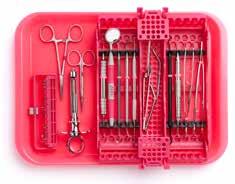

Ask any local manufacturer about Lean Six Sigma or Toyota Production System and you’ll quickly learn that there are a handful of standard operating procedures across an entire industry aimed at improving efficiencies and reducing waste.
A lean clinical workflow is a similar methodology for the dental industry aimed at creating ultimate clinical efficiency, reducing cost and waste of materials, improving staff training, and elevating the patient experience.
Believe it or not, this already exists and it’s been tested in numerous
DSOs, Group practices, CHCs, and Multi-Locations and spoiler: it works.
Without structured clinical systems, organizations may face challenges impacting their efficiency, quality, and overall performance.
Without a lean clinical workflow, teams stress about not having the right tools at the right time, leading to mistakes and less efficiency.
Without a clear clinical system, onboarding and cross-training every employee is difficult, leading to frustration and inefficient processes.
Teams waste time looking for materials, losing money and patient confidence. Streamlining and automating clinical processes matters.
Operatory drawers often become cluttered with supplies, making it difficult to keep track of inventory and leading to the waste of expired materials, affecting the bottom line more than you’re willing to admit.
Patients’ perception of competency and professionalism is vital. Leaving chairside to find tools erodes patient confidence.
Other costs include compliance risks, increased waste, decreased quality, competitive disadvantage, and missed opportunities. Finding the right clinical processes that yield efficiency, increase revenue, and reduce team stress is surprisingly simple!
Ready to watch costs dissolve, and dental teams smile? Then let’s dig into your new lean clinical workflow:
For de novos and remodels, optimizing the space for a lean work environment is crucial.
Questions to consider include:
> Do you have the right space allocated for dirty and clean in central sterilization?
> Are hallways and pathways optimized for maximum efficiency?
> Is the supply room appropriately sized and located?
Cabinetry is expensive but necessary. Recommendations include:
> Minimal cabinetry in the treatment room
> Galley style for central sterilization with a side for clean and dirty, and minimal storage on the dirty side
Effective material placement is pivotal. Key areas include:
1. Central Sterilization: Everything has a place.
2. Treatment Room: Stock each room identically.
3. Storage Room/Closet: Store all disposables and overstock in a “Back Stock” area.
Converting to a new workflow requires careful planning. Seek help and allocate the budget and time to do it right. Search for a clinical efficiency consultant with experience.
P.S. if you’ve made it this far, you must be pretty interested in helping your teams and bottom line. I do this all day every day and would love to help.
But don’t take it from me! Scan here to hear it from Dr. Coryell, Vice President, Clinical Affairs for Advantage Dental+ (80+ locations in six states).

Training on a lean clinical workflow involves a structured approach combining philosophical knowledge with practical application. With the right system and coaching, your team will successfully implement workflow principles.
Disorganization impacts practices through increased stress, mistakes, lower morale, and wasted time, eroding the bottom line and compromising care and patient satisfaction. Embrace lean clinical workflow methodology to achieve remarkable improvements in operational efficiency, cost management, and team performance.
With standardized systems, new employees quickly acclimate, boosting confidence and morale and creating a desirable workplace. This environment allows every team member to perform at their best. By committing to these principles, you invest in your practice’s future, ensuring sustained growth and fostering a culture of continuous improvement.
Ready to watch costs dissolve and dental teams smile? Let’s dig into your new lean clinical workflow and unlock your practice’s full potential. With the right systems in place, the possibilities are endless.

Kate Reinert is a Clinical Efficiency Consultant & Educator at Zirc Dental Products Inc, leveraging 17 years of hands-on experience as a dental assistant. Over the course of her career, Kate has gained valuable insights into the intricacies of patient care and the dental practice environment. Her passion for elevating patient care and achieving clinical excellence is her driving force and infectious enthusiasm.
How to unleash the power of multipliers.
BY GRAHAM GARRISON

Tiffany Fleisch suffered a fall in 2022 while skiing in Utah that left her with an injured shoulder. As a result, her personal and professional life went on pause as she faced the healing journey from two shoulder surgeries and a hand surgery.
Forced to take time off work to recover, Fleisch’s life changed. Professionally, after her injury, she could no longer be the “doer” within the workplace but instead had to become a multiplier. A multiplier, within the content of the workplace, is an individual that empowers their team and encourages innovation and growth from other team members. Conversely,
the opposite of multipliers are diminishers, or team members that intentionally get in the way of a team’s ability to accomplish tasks.
Leaders within the dental industry must figure out how they might accidentally diminish their teams. An accidental diminisher genuinely seeks to support their team but inadvertently hinders their growth. Even
the best dental leaders can have blind spots, and sometimes the things they believe to be helping their teams are actually hindering them.
Often, leaders are the idea generators in the company and are passionate and optimistic about each new idea and project. However, when leaders are always the ones generating ideas, they often don’t give their teams enough credit for how hard a new idea will be to implement on top of daily responsibilities. Also, when implementing new ideas, leaders often forget to leave room for teams to fail and learn from their mistakes, or for them to have opportunities to provide feedback.
To grow, leaders must “look for genius” among team members. This means that instead of evaluating employees on whether they are top performers, consider how each individual is smart or successful at work. In what areas do they excel? What can be done to grow that specific employee, and how exactly are they performing better or worse than others?
“This perspective shift intentionally seeks out the ways that employees are using their individuality to move the company forward,” Fleisch said. When leaders transform their thinking this way, they find out that team
members are often smart in more ways than we give them credit for.
Reform your thinking throughout all aspects of the business: just because someone has ideas doesn’t mean they can put them into action. Leaders must discover their team members’ gifts and talents to determine their best fit in the organization.
As a leader, it often feels as though it is your responsibility to answer all your team’s questions, to provide every single solution, and to drive the entire organization or department forward.
“This is a common misconception,” Fleisch said. In fact, a poor leader will often tell their people what to do better and direct every single move their team makes. These leaders feel like they always must have the right answer, so they micromanage. Employees in this case also know that the leader has the answers, so they come looking to leaders for validation, even if they already know the answer themselves. Sometimes leaders become the roadblock themselves, because if the employee searched for the answer on their own, they’d have the potential to make a mistake, fail, but would learn from it and grow.
Successful leaders allow the space for their team to make mistakes and learn so that they can grow on an individual level. A good leader asks the questions instead of providing the answers. They realize that their people are capable and smart and that they can figure things out for themselves.
A good leader asks the right questions so that their employees can discover and be guided to the
right solutions. “This process allows team members to search for solutions and drive new ideas and innovations that ultimately move the company forward,” Fleisch said. If guided to find the answers on their own, employees will take the initiative and come up with their own unique new solutions and ideas. Leaders shape company outcomes, and it is important for them to recognize that their employees can too.
Leaders should strive to be remembered as someone who helped empower their team, allowed employees to be autonomous and innovative, and helped grow the organization toward success.

When you look around your company, are you able to recognize whether you are the only one holding things up from moving forward? Instead of viewing yourself as the sole person at the company with the knowledge and ability, a leader becomes a genius maker when he or she seeks to pull the people around them up
too. “Genius makers ensure that the employees around them are empowered and are as knowledgeable and successful as the leader,” Fleisch said.
Often, entrepreneurs are good at completing tasks and projects on their own instead of delegating. A leader’s weaknesses are often the overuse of their strengths, and a leader’s superpower can quickly become their accidental diminisher.
As leaders, there are strategies that can be implemented to practice, asking insightful questions and leading employees to come up with their own solutions to problems or questions. At first, when making this shift, leaders will quickly realize that guiding questions can encompass a variety of different scenarios. Start forming guiding questions by considering what the problem is and what questions can be asked to help employees get to the correct solution.
Sometimes, there are scenarios that we aren’t prepared for as leaders, and it is more than OK to have a “cheat sheet” of pre-written questions to guide employees. Creating a list of applicable questions is a great approach to begin giving employees autonomy when they come seeking help. When new scenarios come up, add them to the list, because they will likely assist in other scenarios, or the same situation might happen again.
“Some leaders are naturally good at coaching, taking a step back, and letting their people fail and learn,” Fleisch said. For those that it does not come as easily for, implementing distinct, concrete system to make the process of managing people easier can take abstract ideas and make them achievable.
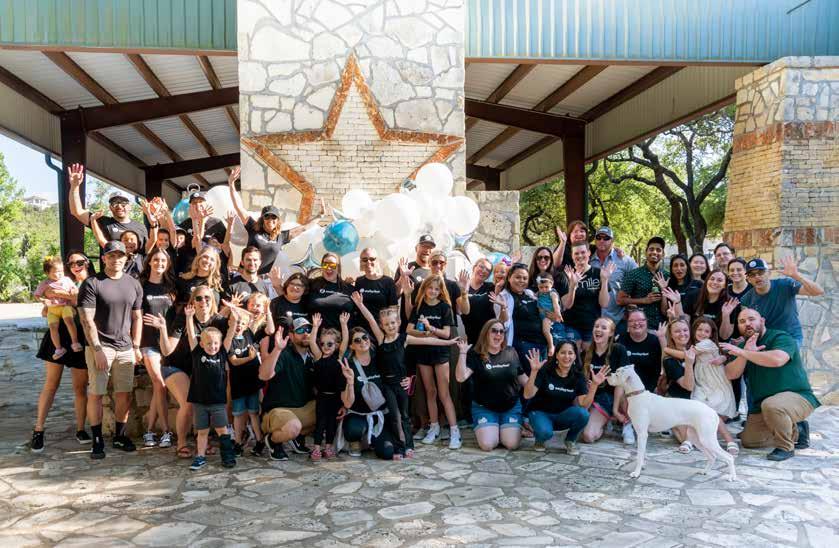
Renken Dentistry’s systems helped it grow and scale in two different states.
BY DANIEL BEAIRD
All your plans can be in place and then life happens. After opening two dental locations in Illinois, Dr. Josh Renken, CEO and founder of Renken Dentistry, moved his family to Texas seeking better care for his daughter who has a rare genetic abnormality.
“We looked around the country to find a place that could support her path and we found a place like that in Austin, Texas,” he said. “So, we decided to go to Austin and open a dental practice, and we’ve opened one per year for the past five years, on average.”
Right away, Dr. Renken learned what was and wasn’t scalable and replicable running practices in two different states. “You take so many things for granted that you think are replicable when you add another location,” he said. “But being in two states is different. It
put a constraint on our business that was hard but healthy.”
As Dr. Renken grew his practices, it was important to him to have something replicable and not personality-driven. “It really was built by design to completely express our values, to pursue our mission, and to be very focused,” he said.
Renken Dentistry developed its Path to Health to help patients create a treatment plan and know what to expect. “I wanted patients to have the same experience no matter what hygienist or what assistant they see,” Dr. Renken said. “We’re all human and there’s going to be some variation, but I wanted to start streamlining things.”
The Path to Health is on every operatory wall at Renken Dentistry locations so even patients can speak the same language. “Our team is on the same page – patients, doctors, hygienists, assistants, everybody,” he said.
When patients walk into a Renken Dentistry office, they see a big sign that states Renken’s mission is leading its teams, patients and practices to greater levels of health.
“We turned our mission into an objective step-by-step path for our team, our patients and our practices,” Dr. Renken said. “Every employee interview filters through that. Performance evaluations and growth check-ins filter through it.”
These paths are on the walls. They are everywhere. “We don’t have office managers or regional managers, but our team’s shared clarity of purpose can replace that human presence,” he said.
“The only way I’m going to help a patient save money over the course of their life is to keep them on the Path to Health,” he added. “So, I can point to that instead of saying let me give you a better discount on advanced disease.”
Renken Dentistry gives patients
five steps on its Path to Health and patients can see where they are on the path. They include:
1. Emergency relief.
2. Understand each other fully.
3. Make a plan together.
4. Active disease under control.
5. Stay healthy together.
“It’s so powerful when you’re communicating with a patient that’s scared,” he said. “If we get to health together, the patient doesn’t have to spend so much time with us. It helps the doctors and hygienists have an objective reference.”
It helps Dr. Renken coach the team too when things don’t go right with a patient. Typically, he can identify where things went wrong on the path. “It might be because we didn’t spend enough time on the second stage of understanding each other fully,” he said. “Either we didn’t understand the patient, or they didn’t understand their health disposition and we moved down this path without being clear.”
If there’s a failure in step three when they plan together, then the doctor might have suggested a crown before the patient even knew what was going on. “Do we spend enough time understanding the patient’s health before we start talking about solutions or plans,”
Dr. Renken asked. “That’s a nice way to show our team what we do.”
If failure is in the fourth step and the patient doesn’t want to spend money to get an advancing disease under control, things will only get more expensive for them. “It only gets more debilitating with more chances for pain every day if we don’t get them off of the fourth step – getting the disease under control,” he said. “Are we going to get the disease under control or are we going to go all the way back to step one?”
For every doctor on the Renken Dentistry team, there are two to three assistants and one to two hygienists. If it’s an office with two doctors, then there are five assistants and three hygienists if the office is single column. And there are no administrators.
“We invest a lot of development in our dental assistants but they’re doing so many things because there’s no administrators,” Dr. Renken said. “Somebody’s in charge of grabbing the mail, but you have to have systems around just the simplest tasks that administrators used to do.”
Renken Dentistry has kiosks at the front for patients to check in through Open Dental.
“There’s all these interactions you have to design for,” he said. “But they’re regular and easy to organize around. We use a ticketing system that flows up to our central management team because you can lose the goodwill of your clinical team if they don’t feel supported and someone’s going to solve their problems.”
> Business: Patient Experience
Central patient coordinators virtually present to the clinical team at the beginning of each day. They talk about their results from the day before and have a riddle of the day or a contest for the clinical team. Maybe they have some music playing.
“They just get the day started and the clinical team doesn’t have to do any of that,” Dr. Renken said. “They organize the huddle, which was a challenge in the old days of administrators because everyone would argue over it or not have time because patients were calling, or someone was setting up chairs.”
Now, the clinical team walks in ready to be presented with their perfect day and the day’s goal. It’s a good checkpoint to check on any issues that have arisen. It can also be fun and drive culture. “Whether you have two practices or seven or 10, you can push out news to make sure everyone’s getting the team news. You can also push out a little system update or anything like that,” he said. “So, it’s very structured and there’s a lot of value in it that we didn’t have before when each office was doing their own thing.”
Having two to three assistants for every doctor allows Renken Dentistry to handle treatment plans, seating patients, taking X-rays, collecting payments, and more without an administrator on site. “If the doctor is in one room and they’re in another, there’s still an extra assistant around to present treatment and we teach a very structured treatment presentation,” Dr. Renken said. “We monitor a metric called our care progress rate to see how successful they are at that.”
Dr. Renken says most of their offices are around 50-55% of patients taking the next step, and offices can get competitive over that. Renken Dentistry shows their offices which ones have the best progress rate. “We can get some good days when we’re at 60%, 70% or 80%,” he said.

The new patient experience can be complicated between insurance verification and interactions with patient coordinators. Renken Dentistry tackles this through a call center that’s broken into four groups:
1. New patient coordinators.
2. Existing patient coordinators.
3. Operators.
4. Outbound coordinators.
“Our new patient coordinators are our all-stars on the phones,” Dr. Renken said. “They consistently have an 85-90% conversion rate.”
It goes through a ticketing system that routes to the insurance verification team. There’s some automation to verify insurance but there’s also a human backstop to take the ones that can’t be automated. Dr. Renken says the goal is to have as many insurance
verifications done as possible 48 hours before a new patient is scheduled. “That’s one of our biggest workloads because if you’re in a de novo space and you have a lot of new patients, it can get a little hairy,” he said. “So that definitely needs to be ironed out.”
New patients enter a Renken Dentistry office and enter their name and birthdate in a front office kiosk and a light goes on in the back office on all computers that a new patient has arrived. “Our chairs and our welcome space are intimate,” Dr. Renken said. “Our team is walking around and seeing people come in. They rarely wait for more than a few minutes to get into a chair with nine chairs and two doctors. That typically makes people pretty happy.”
New patients have 90 minutes with a hygienist or start with an assistant in the restorative column or chair and complete the second half of the appointment with a hygienist. They also go through an iTero wellness scan. “We have a laminated form for exactly how a new patient encounter goes,” Dr. Renken said. “It’s in every room and office. It’s always the same. We’re just following the Path to Health and there’s an encounter form for each step.”
Renken Dentistry uses a QR code for complicated insurance questions because its clinical team was frustrated trying to answer those questions and translate them. So, it has a QR code that sends these questions directly to its insurance team.
“We mark it ‘In Chair’ so it’s an urgent ticket that the team is going to

get on right away,” he said. “Or in other cases, a patient might have a complicated billing or insurance question and we give the patient a QR code that they can upload on their phone and follow the ticket through themselves.”
Automation posts the dialogue into Open Dental, including the ticket resolution or lack thereof, so the office can follow the progress. All of the information is attached to a patient’s record, and it makes it easier to handle. “There are so many patients that you want to have a record of the dialogue as opposed to it being a free-forall on the phone,” Dr. Renken said.
Renken Dentistry has been through multiple ticketing systems, but Dr. Renken thinks the most important thing is having an omnichannel system for the central team. “We have the practices, the clinical team members, and the patients,” he said. “There are so many routes of
input now. We use Freshdesk as our provider and it’s built on Twilio. It’s omnichannel so chats can come in through Facebook, Google, phones, texts, and all those QR codes that come in as tickets.”
That allows Renken Dentistry to get to a common theme around support, velocity, and assurance at its central management level.
Renken Dentistry has another five-step path for its clinical team including:
1. Living the way.
2. Delivering the way.
3. Growing the way.
4. Leading the way.
5. Teaching the way.
“You go from living the mission to delivering the way to growing as
a team member,” Dr. Renken said. “And some team members want to grow professionally and assume more leadership or responsibility around the office. We have a leadership program that they go through and achieve certification.”
Lastly, Renken Dentistry has a teaching-the-way program that team members can participate in by mentoring new team members through steps one and two – living the mission and delivering the way –and they are compensated for it.
For its doctors, Renken wants diversity of thought on how to get advancing diseases under control.
“That’s the benefit of being in a group,” Dr. Renken said. “But on the flip side, our structure is like a checklist manifesto – before, during, and after – for each of those steps on the Path to Health. It’s like a training guide.”
Unlocking practice potential through strategic associate development.
Dental associates play a vital role in driving every dental business’s growth, enhancing revenue, and optimizing operational efficiency. Effectively managing and onboarding associate dentists is essential for the long-term success and sustainable growth of any growing dental practice / dental group / DSO. Here are actionable strategies and best practices curated from DEO’s experiences working with the country’s top dental entrepreneurs, leaders, group owners, CEOs, and practice owners to hire, onboard, manage, and retain qualified dental associates for enhanced business outcomes.
Associate dentists are the backbone of dental practices. Recognizing their value and potential is fundamental for achieving business objectives and
fostering organizational success. They play a pivotal role in reducing chair time and driving revenue. Their job satisfaction and career development should be kept in mind at all times for the healthy growth of your practice.
To attract and retain top-tier dental associates, a structured hiring plan is non-negotiable. This plan should be meticulously documented and tailored to ensure a steady influx of qualified candidates.
One of the most overlooked yet impactful aspects of hiring is creating a clear picture of the ideal associate dentist for your practice. By defining key attributes, skills, and values, you can develop a comprehensive profile that will guide you throughout the hiring process.

This strategic approach minimizes wasted time and resources while maximizing the likelihood of finding the perfect fit.
Also, automate the process as much as possible: utilizing automation tools for recruitment processes, such as hiring websites and email responses, optimizes efficiency, saves time, and provides comprehensive information to potential candidates.
The significance of a robust onboarding process cannot be overstated. Beyond mere paperwork and orientation, a well-designed onboarding program sets the stage for long-term success and employee satisfaction. From pre-arrival preparations to ongoing support and feedback, each step should be carefully planned to ensure a seamless transition and foster a culture of excellence.
Transitioning to digital onboarding systems streamlines paperwork and compliance tasks, enhancing the pre-arrival experience for new associates.
Creating a warm welcome atmosphere with swag and essential resources fosters a positive initial impression and sets the tone for a successful onboarding journey.
Communicating schedules, productivity targets, and performance

expectations from the outset minimizes uncertainty and promotes a sense of direction and purpose.
Providing new associates with a documented plan for their first week, including access to training materials and equipment instructions, facilitates a smooth transition into their roles.
Regular check-ins, clinical reviews, and performance evaluations ensure associates feel supported, and valued, and have opportunities for growth and development within the organization.
Maintaining open lines of communication, evaluating performance metrics, and providing personalized coaching and development plans foster engagement, motivation, and continuous improvement.
Mastering the onboarding process is instrumental in retaining top talent, cultivating a culture of excellence,
and positioning the organization for sustained growth and success. By prioritizing effective associate dentist management and onboarding, dental entrepreneurs, leaders, group owners, CEOs, and practice owners can unlock the full potential of their teams and keep focused on reaching their next growth milestone.
Ultimately, the true measure of success lies in your ability to retain talented dental associates and nurture their professional development. By prioritizing ongoing communication, performance evaluations, and personalized coaching, you demonstrate commitment to their growth and well-being. This proactive approach not only fosters loyalty but also cultivates a thriving practice culture built on mutual respect and collaboration.
Take time to put in place a structured hiring, onboarding, and retention process for associates to ensure strong long-term health and growth of your dental business.
Strategies for a strong dental group P&L.
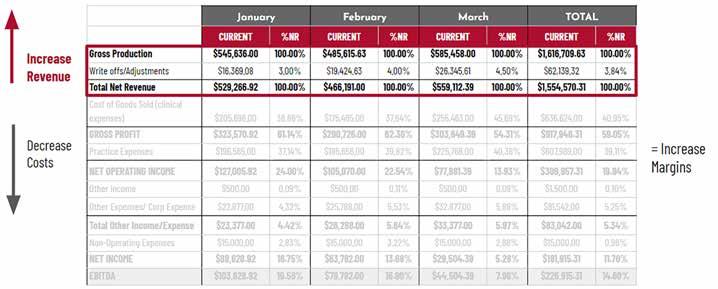
Last fall at DEO’s Bottom Line Boot Camp, Jake Puhl, CEO of the DEO, discussed how to boost business growth without adding costs to your dental group’s P&L with successful dental entrepreneur Dr. Dipesh Patel. As CEO/ CFO of Blueprint Smiles, a dental group with 7 practice locations in Georgia, Dr. Patel shared lessons learned and pitfalls to avoid for dental entrepreneurs and dental leaders seeking to scale.
Dr. Patel, a long-standing member of DEO, has transformed Blueprint Smiles from a modest single practice into an impressive 7-location dental group generating multi-million dollars in annual revenue. One secret to their success isn’t a mystery: it’s a core value of “respect time” that drives their
dental business’s expansion and ensures a strong P&L.
Precise strategies are fueling Blueprint Smiles’ growth without the financial strain. From smart time management tactics to outsourcing approaches, Dr. Patel shared wisdom that can elevate the growth trajectory of any dental practice / dental group / DSO.
When Blueprint Smiles was a single location, efficiency was nonnegotiable. Every decision counted, and every minute mattered. Dr. Patel knew the key to progress wasn’t just growth for growth’s sake. It was about strategic, controlled expansion while preserving the core values of efficiency and excellence. With a small staff, he ensured each operational step was finely tuned, laying a strong foundation for Blueprint Smiles’ P&L and growth journey from a small office to a thriving 7 location dental organization.
He advises dental entrepreneurs and leaders just beginning to scale to focus on streamlining processes and meticulous attention to detail.
Strategic outsourcing can be an effective strategy for a dental group’s financial playbook. Dr. Patel recognized this power and capitalized on it, using virtual platforms and remote teams to handle front-end responsibilities efficiently.
This move wasn’t just about cost-cutting, and protecting their P&L but smart resource reallocation. By delegating these tasks effectively, Blueprint Smiles could redirect funds toward boosting back-end salaries. Thereby increasing employee retention and satisfaction, creating a
win-win situation for Dr. Patel’s vision as a dental entrepreneur, for his growing dental group, and for his team.
To sustainably scale a dental company today, you must continually adapt to the ever-evolving economic and consumer landscape. Dr. Patel focused on optimizing existing systems and integrating technological tools to contain costs, maintain a strong P&L, operate efficiently, and maximize output without unnecessary financial inflation.
Streamlining processes, leveraging technology, and fine-tuning operational workflows are crucial components for any dental practice / dental group / DSO’s efforts in navigating the current environment without allowing costs to spiral.
Handoffs between clinicians in a dental practice can sometimes resemble a relay race: Dr. Patel advocates for minimizing these transitions. Reducing handoffs means more than just minimizing potential errors; it’s about reclaiming time.
Streamlining processes and minimizing unnecessary transitions frees up valuable time for clinicians. Whether focusing on patient care using valuable time for professional training / leveling up skills or exploring strategic moves within your dental practice / dental group / DSO, reducing handoffs allows for a more hands-on and impactful presence for patients beyond the dental chair as well as clinicians’ job satisfaction.
Leverage the benefits of digital advancements to provide durability and aesthetics to patients in fewer appointments.


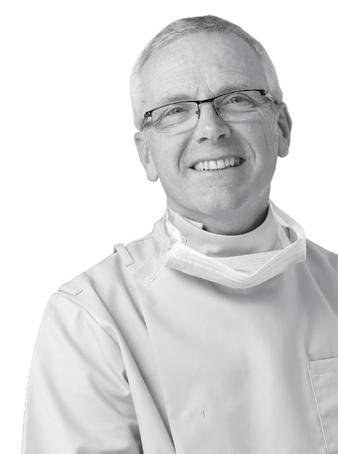
BY JONATHAN BONANNO, PH.D. CANDIDATE, MSM, CTOC, CSBR | CHIEF EXECUTIVE OFFICER & INDUSTRIAL/ORGANIZATIONAL PSYCHOLOGIST, ZIA
In today’s competitive business landscape, the success of an organization hinges on its ability to attract and retain top talent. However, the journey does not end with recruitment. To fully leverage the potential of their employees, companies must integrate talent acquisition with talent optimization. This comprehensive approach ensures that the right individuals are hired and that they are effectively engaged, developed, and retained.
Talent acquisition is the strategic process of identifying and recruiting suitable candidates to fill positions within an organization. Unlike simple recruitment, talent acquisition encompasses long-term workforce planning and development. Effective talent acquisition requires a deep understanding of the organization’s needs, clear role definitions, and sourcing candidates who not only possess the necessary skills but also fit the company culture (Cappelli, 2008).
A robust talent acquisition strategy involves several key components:
1. Employer Branding: Establishing a strong employer brand that attracts high-quality candidates by showcasing the company’s culture, values, and benefits.

2. Targeted Recruitment Marketing: Utilizing various channels, such as social media, job boards, and recruitment agencies, to reach potential candidates.
3. Efficient Selection Processes: Implementing thorough screening and interview procedures to identify candidates who align with both the technical requirements and cultural fit of the organization (Phillips & Gully, 2015).
Successful talent acquisition not only fills immediate vacancies but also builds a talent pipeline for future needs. This proactive approach reduces the time and cost associated with hiring and ensures a steady supply of qualified candidates.
Once the right talent is acquired, the focus shifts to talent optimization.
Talent optimization involves aligning people strategies with business goals to ensure that employees are engaged, productive, and motivated to perform at their best. Key areas of talent optimization include:
1. Onboarding: Effective onboarding helps new hires integrate smoothly into the organization, increasing retention and accelerating time-to-productivity (Bauer, 2010).
2. Employee Development: Providing continuous learning and development opportunities to keep employees engaged. This includes training programs, mentorship, and career advancement opportunities (Noe, 2017).
3. Performance Management: Regular feedback and performance reviews help employees understand their strengths and areas for improvement, fostering a culture of continuous improvement (Aguinis, 2019).
4. Employee Engagement: Engaged employees are more productive and committed to the organization’s success. Enhancing engagement involves recognizing and rewarding achievements, promoting worklife balance, and ensuring open communication (Robinson, Perryman, & Hayday, 2004).
5. Retention Strategies: Retaining top talent is as crucial as acquiring


Ä Leadership in Psychology
Ä Comprehensive Talent StrategyVirtual and Onsite Teams
Ä Customized Solutions
Recruitment and Selection:
Ä Identify and attract top talent for various roles within dental offices, DSOs, and emerging dental groups.
Ä Conduct comprehensive candidate sourcing, screening, and interviewing processes.
ZIA, led by Industrial Organizational Psychology PhD Candidate, Jonathan Bonanno, specializes in providing top-tier talent solutions tailored specifically for emerging dental groups and Dental Support Organizations (DSOs).Our comprehensive approach includes both virtual and onsite team integration, ensuring your people strategy aligns seamlessly with your business strategy.

From single locations to large networks, we recognize the unique nature of every dental organization. Our strategies in psychology and human resources with an emphasis on cultural competency and organizational development aligns with our holistic approach to talent management, from recruitment and integration to ongoing professional development and performance optimization.
Organizational Structure
Development:
Ä Assist in designing and implementing effective organizational structures for DSOs and emerging dental groups.
Ä Provide strategic advice on team composition, roles, and responsibilities to optimize operational efficiency.
Culture and Engagement
Enhancement:
Ä Assess organizational culture and employee engagement levels.
Ä Recommend strategies to foster a positive work environment and improve employee retention.
Tailored Support for In-House Recruiters: Already have an in-house recruiting team? Perfect! We partner closely with your recruitment team, providing the expertise and resources needed to attract and retain top-tier talent effectively.
it. Effective retention strategies include competitive compensation, benefits packages, and creating a positive work environment (Allen, Bryant, & Vardaman, 2010).
Integrating talent acquisition with talent optimization creates a seamless experience for employees from their first day on the job. This synergy ensures that investments in acquiring top talent translate into sustained performance and organizational success.
1. Aligned Goals: Aligning talent acquisition and optimization efforts ensures the organization attracts candidates who are a good fit for current needs and have potential for future growth, building a resilient and adaptable workforce (Cappelli, 2008).
2. Consistent Experience: Providing a consistent and positive experience from recruitment through onboarding and beyond increases employee satisfaction and loyalty, encouraging long-term retention (Bauer, 2010).
3. Data-Driven Decisions: Utilizing data and analytics in both talent acquisition and optimization offers insights into employee performance, engagement, and retention, aiding in informed decision-making and continuous process improvement (Phillips & Gully, 2015).
4. Cultural Fit: Ensuring cultural fit during hiring and reinforcing it through ongoing engagement and development initiatives creates a cohesive work environment where employees thrive (Noe, 2017).
5. Leadership Development: Integrating talent acquisition and optimization helps
identify and develop future leaders within the organization, building a strong leadership pipeline (Aguinis, 2019).
To effectively integrate talent acquisition and talent optimization, organizations can take the following practical steps:
1. Collaborative Planning: HR and leadership teams should collaborate to develop comprehensive strategies covering both acquisition and optimization.
2. Continuous Feedback Loop: Establish mechanisms for continuous feedback and improvement across all stages of the employee lifecycle.
3. Investment in Technology: Leverage technology and HR analytics to streamline processes and gain valuable insights.
4. Employee-Centric Approach: Focus on creating a positive and supportive environment that prioritizes employee well-being and growth.
Implementing these steps allows organizations the opportunity to create more sustainable workforces to drive long-term success.
In closing, the integration of talent acquisition and talent optimization is essential for building a thriving workforce. When we prioritize strategically acquiring top talent and continuously optimizing their experience, organizations can enhance performance, engagement, and retention. This holistic approach benefits employees and drives organizational success in today’s competitive landscape.
References: Allen, D. G., Bryant, P. C., & Vardaman, J. M. (2010). Retaining talent: Replacing misconceptions with evidence-based strategies. Academy of Management Perspectives, 24(2), 48-64. Aguinis, H. (2019). Performance management for dummies. Wiley. Bauer, T. N. (2010). Onboarding new employees: Maximizing success. SHRM Foundation’s Effective Practice Guideline Series. Cappelli, P. (2008). Talent management for the twenty-first century. Harvard Business Review, 86(3), 74-81. Noe, R. A. (2017). Employee training and development (7th ed.). McGraw-Hill Education. Phillips, J. M., & Gully, S. M. (2015). Strategic staffing (3rd ed.). Pearson. Robinson, D., Perryman, S., & Hayday, S. (2004). The drivers of employee engagement. Report 408, Institute for Employment Studies.

Jonathan Bonanno is a pioneering figure in recruitment process outsourcing (RPO) solutions for dental service organizations and emerging groups. With over a decade of experience in healthcare and on the verge of completing a doctoral degree in Industrial/Organizational Psychology, Jonathan is committed to improving workforce performance and driving organizational success. Jonathan’s mission is to empower healthcare professionals to build resilient, high-performing, and psychologically safe teams. His insights on talent optimization and team dynamics promise to inspire and transform the approach of industry leaders.

The ADSO’s ongoing journey.
BY ANDREW SMITH, CHIEF EXECUTIVE OFFICER, ADSO
In June, the Association of Dental Support Organizations (ADSO) brought together an array of experts and pioneers across the dental industry, showcasing thought leadership and innovation at the 2024 ADSO Summit. Featuring keynote addresses, insightful panels, and collaborative breakout sessions, the Summit celebrated our Association’s collective progress and outlined our future direction.
During the Summit – named “Dentistry’s Main Event” – I had the privilege of presenting the “State of the DSO Industry” report, highlighting how far the ADSO has come from our humble beginnings. This gathering underscored the pivotal role that the ADSO plays not only in supporting dental professionals, but in also helping to ensure access to high-quality dental care to communities nationwide.
Over the past two decades, the dental support organization (DSO) industry has transformed from a nascent concept and into a key player in modern dentistry. When ADSO was first established, it began as a small study club for a handful of entrepreneurs with a novel idea about how to revolutionize the dental industry. Today, the ADSO is a respected thought leader within our industry.
The ADSO’s growth is a reflection of what can be accomplished through innovation, strong partnerships, and collaboration. Today,
we have grown from a small group and into an association consisting of over 80 members, representing 8,500 practice locations, and supporting 15,000 dentists across the nation. But our expansion is not just about numbers and figures. It is about the meaningful impact we are making both on the dental industry and the communities we serve.
Since our founding, the ADSO has proudly championed forwardthinking policies and initiatives, from supporting important state legislation to providing resources for the next generation of dental care providers, as demonstrated by our innovative DSO Difference tool. Through our collaboration with policy experts and industry professionals, for example, the ADSO has been instrumental in devising innovative solutions to the ongoing dental workforce shortage, successfully advocating for license portability laws. Today, thanks to efforts between our Association and our partners across the dental industry,
nine states have joined the Dentist and Dental Hygienist Compact.
Our commitment to being part of the solution to the challenges faced by modern dentistry extends beyond ensuring we have enough dental professionals to care for our growing population. In 2022, the ADSO supported a historic ballot measure in Massachusetts, establishing a dental medical loss ratio (MLR) standard. This policy ensures that patients’ premium dollars are being used to provide them with high-quality dental care. More, this landmark reform also creates greater transparency and accountability in dental insurance, creating a model for other states to follow.
The ADSO’s work is far from over. As demonstrated at the 2024 ADSO Summit, we are forging long-lasting partnerships with movers and shakers across the dental industry. These relationships, highlighted through the thought leaders featured on our panels and discussions, are crucial to our success and continued leadership in modern dentistry.
The evolution of ADSO from a small study club to an industry leader is a testament to the vision and dedication of our members and partners. We are proud of our accomplishments and excited about the opportunities that lie ahead.
Achieve operational excellence with these must-track KPIs for dental practices.
BY CHRIS KEYSER, DEO
In the dynamic world of dental practice management, implementing key performance indicators (KPIs) is essential to drive growth, improve efficiency, and ensure accountability. KPIs provide a quantifiable measure of performance, offering insights into various aspects of the practice. By focusing on the right KPIs, dental practices can enhance their operational efficiency and overall success.
Here’s a look at the top five KPIs for key positions in a dental practice, curated from DEO’s extensive experience with successful dental organizations.
1. Dentist Production: For dentists, particularly associates, measuring production per hour is crucial. This KPI tracks the revenue generated by each dentist and helps identify opportunities to increase efficiency and productivity. It ensures that the dental team is contributing effectively to the practice’s financial health.
2. Treatment Acceptance Rate: The treatment acceptance rate is a critical KPI for both dentists and treatment coordinators. This metric measures the percentage of proposed treatments that patients accept. A high acceptance rate indicates effective communication and trust between the dental team and patients, leading to better patient outcomes and increased revenue.
3. Reappointment Rates for Hygienists: For dental hygienists, reappointment rates are a key indicator of patient retention and satisfaction. This KPI measures the percentage of patients who schedule their next appointment before leaving the practice. High reappointment rates suggest that patients are committed to their ongoing dental care, which is essential for maintaining a steady patient flow.
4. Call Conversion Rate for Front Office Team: The front office team plays a crucial role in patient acquisition and retention. The call conversion rate measures the percentage of incoming calls that result in scheduled appointments. This KPI is vital for assessing the effectiveness of the front office staff in converting inquiries into appointments, directly impacting patient flow and revenue.
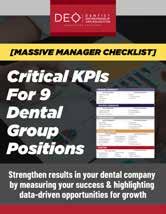
5. Insurance Claims Processing Time: For insurance coordinators, the speed and accuracy of processing insurance claims are critical. This KPI tracks the average time taken to process and submit claims, as well as the percentage of claims paid within 30 days. Efficient claims processing ensures a steady cash flow and reduces the risk of financial discrepancies.
Tracking these top five KPIs provides a clear picture of each team member’s performance and highlights areas for improvement. By focusing on these metrics, dental practices can drive better results, foster accountability, and ensure that every team member is aligned with the practice’s goals.
To explore more KPIs and implement them effectively in your practice, download our comprehensive guide, “Manager Cheat Sheet: KPIs for 9 Dental Group Job Positions,” by scanning the QR code. This resource is part of the DEO Growth Model and includes detailed KPIs, helping you streamline your KPI selection and enhance your practice’s performance.



INSURANCE COORDINATOR
Roles & Responsibilities
INSURANCE COORDINATOR
Insurance
INSURANCE COORDINATOR
Roles & Responsibilities
Denials/appeals
Denials/appeals
Verification
TREATMENT COORDINATOR
Roles & Responsibilities
TREATMENT COORDINATOR
Financial arrangements
TREATMENT COORDINATOR
Schedule treatment
Roles & Responsibilities
Roles & Responsibilities
Follow-up on unscheduled tx
Financial arrangements
Financial arrangements
Schedule treatment
Schedule treatment
FRONT OFFICE TEAM
Follow-up on unscheduled tx
Follow-up on unscheduled tx
Roles & Responsibilities
FRONT OFFICE TEAM
Answer phones
FRONT OFFICE TEAM
Build
Roles & Responsibilities
Roles & Responsibilities
Answer
Over-the-counter collections
Answer phones
Data entry
Build & maintain schedule
Over-the-counter collections
Over-the-counter collections
Data entry






VOCO offers a full range of competitively-priced
and more
Reduce supply costs with products that provide crossover indications
Award-winning products that deliver proven results to maximize patient quality care
Simplified procedures to drive clinician satisfaction with innovative products
Deliver added value to your team through VOCO’s extensive and customizable continuing education options

